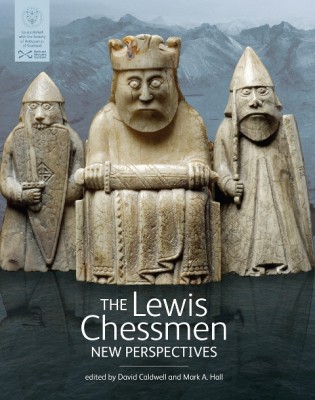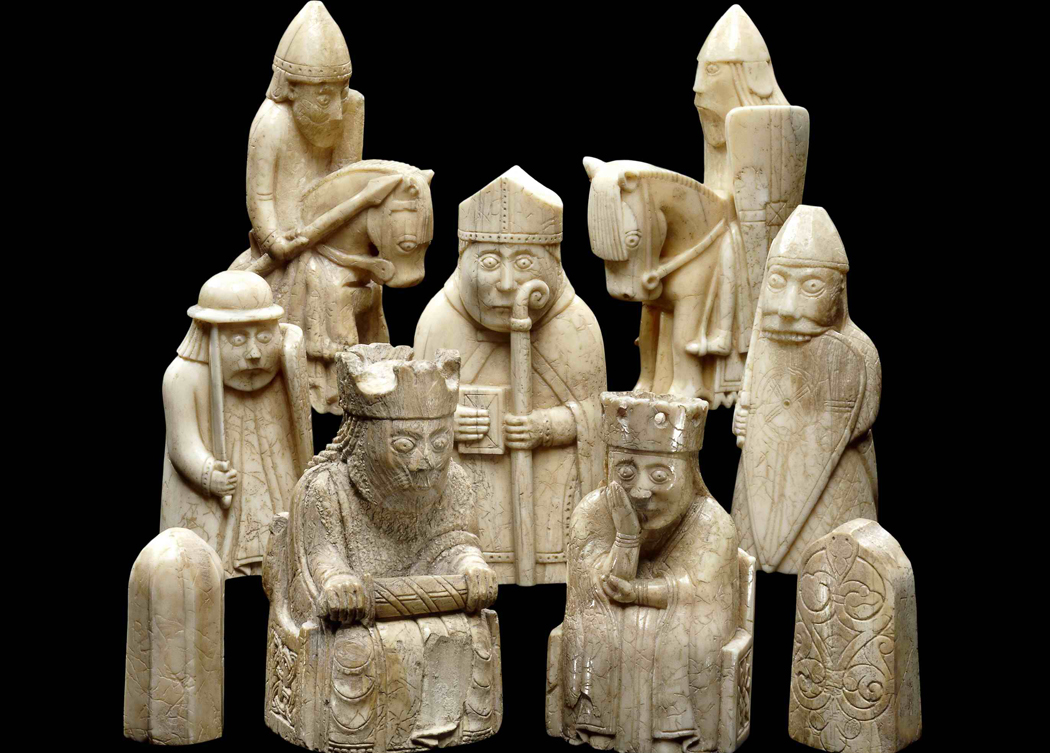The Lewis Chessmen are simply amazing. New book captures their spirit while presenting us with a very detailed look of the material they were made of and how they were produced.
The Lewis Chessmen belong to a group of archaeological objects, which nearly everyone knows and can identify by sight. 78 pieces in all, they were miraculously found in 1831 on the Isle of Lewis in the Outer Hebrides. A later report tells that they were found hidden in a shallow stone built box in a sand dune right off the coast together with 14 tablemen and a belt buckle. A study of the style reveals that they were probably carved sometime between 1150 -1200.
We know them of course so well because they are used in every single publication about Vikings, we can think of. In a sense they have defined our idea of vikings looked like – kings, queens, thrones, crowns, shields, berserkers, bishops and warders. It seems we cannot stop looking at these little marvels!
 It stands to reason that the Lewis Chessmen since they were found have been studied from all angles and published in very many contexts. However, apart from pamphlets no major book has until now been devoted to the tiny figures. Now, though, a recent book published by The National Museum of Scotland in conjunction with the Society of Antiquaries of Scotland amends this.
It stands to reason that the Lewis Chessmen since they were found have been studied from all angles and published in very many contexts. However, apart from pamphlets no major book has until now been devoted to the tiny figures. Now, though, a recent book published by The National Museum of Scotland in conjunction with the Society of Antiquaries of Scotland amends this.
The book is a collection of articles stemming from a conference held at the national Museum in Scotland in 2010 in connection with the exhibition there of the total collection (some pieces are held at the British Museum and were on loan for the occasion). However, this is not a mere collection of articles. It is in fact a very well-edited presentation of the Chessmen and their material, artistic and historical context.
In the first section we get a very detailed presentation of the chess pieces and their physical appearance. By studying for instance their visual expressions it is possible to determine that at least five artists might have been involved. But we also get details about the fact that the chess-pieces were probably partly painted. And we get information about aspects of the life-world, in which the chessmen were understood – where did the idea of the berserkers stem from and what might we learn from the pieces about queens and their roles. Not least the question is raised, how we should understand the different gestures of the figurative pieces.
The second section is devoted to recovering the political and geographical context: the Kingdom of the Isles, Manx, Norway, Iceland and the sea world of the chessmen in which they were made. Along the way, we also get a fine introduction to Walrus hunting and the ivory trade in the North Atlantic. Not least the enigmatic nature of the Kingdom of the Isles and the life-world of the chessmen is explored. An understanding of both the hoard and the Kingdom seems to be inextricably interlinked, writes hall and Caldwell in the introduction.
The third section touches more specifically on the context of gaming. What was the cultural value of such chessmen, who might have bought them (or had them gifted), how was the game of chess played, how does it relate to the ‘hnefattafl’ (the icelandic game) and finally what role did games play in Old Norse-Icelandic fiction and cultural context. In a particularly rewarding essay Heather Pulliam makes the point that the Lewis Chessmen figuratively makes it very easy for the player to identify with the figure in question. Compared to the Chess-pieces of Charlemagne, where the king is wrapped in his castle and with flanking attendants, the thrones of the Lewis kings are nearly invisible, exposing the them as ‘persons’ more than ‘incumbents of royal offices’.
This is a splendid collection. It invites the reader to delve into the laboratory of the learned archaeologists and historians, trying to wring as much information out of every detail as possible. And the devil really lies in the detail here. But it also presents us with sketches to a better understanding of the context, in which the Lewis Men were meant to be paraded, admired and played with.
The published volume, however, does not present us with a well-rounded presentation of the Lewis men. (In fact it lacks a preliminary presentation of the hoard and it took me some time to locate it in the back of the book). But it does present us with a collection of articles, which as bits and pieces bring our knowledge of the chessmen singularly forward.
This is really a worth-while read.
Karen Schousboe
The Lewis Chessmen. New Perspectives
Edited by David H Caldwell and Mark A Hall
Published by NMS Enterprises Limited 2014
ISBN 978 1 905267 85 9
ABOUT THE AUTHORS
David H Caldwell was formerly Keeper of two departments in National Museums Scotland – Scotland and Europe, and Archaeology.
Mark A Hall is History Officer for Perth Museum and Art Gallery, where he is principally responsible for the curation of the archaeology collections.
